
Bounded by the Caspian Sea and the Caucasus Mountains, Azerbaijan is a country squeezed between Europe and Asia. Its capital, Baku, is popularly known for a medieval walled Inner City, and among its most famous sites is Yanar Dağ (or “Burning Mountain“), a mountain near the Caspian Sea that features a natural glowing fire that has been ‘burning’ more than 65 years. It is no wonder that many nick-name the country “the land of fire”. Among its treasures is another place known as “Medieval Agsu City”, where important archaeological investigations are being carried out………..
Created in 2019, the “Medieval Agsu City” State Historical-Cultural Reserve of the State Service of Cultural Heritage Conservation, Development and Rehabilitation under the Ministry of Culture of the Republic of Azerbaijan, is located in the Agsu district, Azerbaijan. In the 18th century, the medieval city of Agsu was the largest settlement in Azerbaijan in terms of population and territory. Built by Nadir Shah in May 1735 near the village of Agsu, Covering a 40-hectare area,.the fortress-city has long been the residence of rulers appointed by the Shah to the region – the Shirvan khans. The Agsu fortress is also considered to be the center of the revolts of Shirvan nobles against Nadir Shah. At various times, the Russian commander Count Valeryan Zubov and Naibussaltana Abbas Mirza attacked and besieged the fortress. Some of them even captured the castle. Famous 18th century travelers Samuel Gmelin, Bieberstein, Bronevsky and others have reported on the fortress. During the reign of the Shirvan khans, Agsu crafts, trade and culture developed to a high level.
Archaeological Excavations: What They Have Revealed
The first archaeological exploration work in the area was carried out in 1983 by the Agsu-Ismayilli expedition. More recently, however, the joint Agsu Archaeological Expedition has been conducting excavations of the medieval city through the Institute of Archaeology and Ethnography of ANAS and the National History Museum of Azerbaijan.
Despite being built in a short time, the most perfect urban planning of its time was applied. Stone-paved streets and roads, water and sewer lines, handicraft workshops, etc. discovered during the excavations tell the story of a modern progressive urban culture for its time. The interior and exterior walls, floors, roofs, as well as ovens and hearths of the houses in Shirvan were painted with a solution made of special rock called “juice”. This paint solution not only beautified houses, but also protected them from rain. One of the most interesting workshops in the city is a paint shop. The paint dusts found here were studied by an employee of Marmara University in Turkey. It turned out that the painting material was obtained from the madder (Latin “Rubia Tinctorium L”). Because the production and export of madder is one of the main events of the 18th century, this historical period is sometimes called the “Madder century”.
During the research, large public buildings with interesting architectural solutions – underground baths, the Juma Mosque, and ice house – were discovered in the area. There are large cemetery remains on 3 sides of the city.
_____________________________
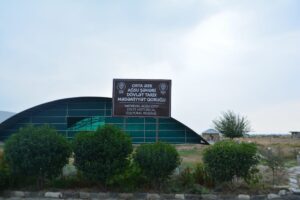
“Medieval Agsu City” State Historical-Cultural Reserve
_____________________________
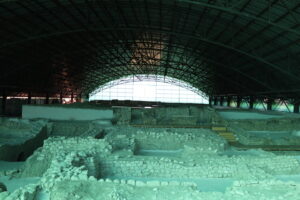
Bath complex, 4th excavation site.
_____________________________
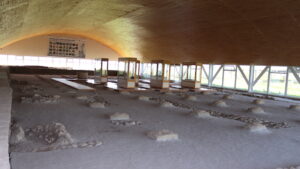
Mosque (Juma Mosque)
_____________________________
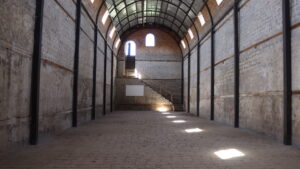
Storage (ice storage)
_____________________________
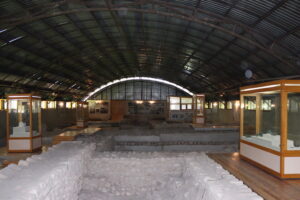
Handicraft quarter
_____________________________
The reserve features 19 historical monuments. All of them are of local importance. Three of them are architectural monuments, while others are archaeological monuments. These monuments include the “Ancient Bath Complex”, the “Juma Mosque”, the “Main Square”, the “Buzkhana (ice house)”, and the “Handicrafts Quarter”, as well as other monuments in the area.
The remains of magnificent medieval buildings were uncovered while exploring the tomb in the Shikhmezid neighborhood of Agsu city, based on oral information of local residents received by the leadership of the Agsu archaeological expedition in 2012. At that time, preliminary archaeological excavations were carried out there in order to save the monument. Thus, the remains of a magnificent rectangular building built towards Mecca, using large accurate minestones, were discovered. The building consists of a large hall covering an area of about 400 square meters and a large number of relatively small rooms.
Fine tile patterns decorated with geometric and floral elements prevail among the finds revealed during the excavations. Architectural features, construction in the direction of Mecca, decoration with colored tiles and the existence of rooms around which hearth remains were found, increase the likelihood that the building is a mosque or the madrasah part of khangah.
_________________________________
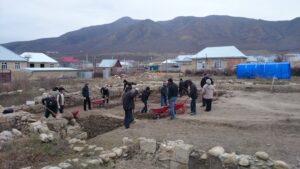
Above and below: The Shikhmezid excavations
_________________________________
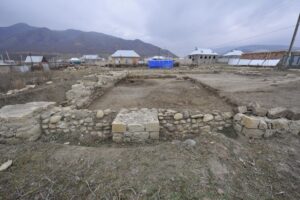
_________________________________
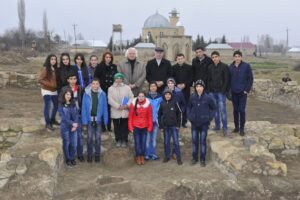
_________________________________
Although the people within the graves found in this area were buried according to Islamic rules, i.e. over the right shoulder and towards Mecca, more interesting facts emerged. Most of the graves were covered with 4, 6 or 8 jars. Such a burial custom has not yet been found in any Muslim country. Anthropological research revealed that the skull samples, which undoubtedly belonged to Muslims, are particular to the “Caspian” anthropological type, which represents local Azerbaijanis.
According to elderly residents of the region, the khangah and the tomb in the Shikhmezid neighborhood were destroyed as part of measures taken by the Soviet regime in the 1930s. The analysis of the finds displayed in the upper layer during the preliminary research shows that the Shikhmezid khangah complex, Shikhmezid tomb, Narli pir, and graves with jar covering, belong to the XIII-XVII centuries. They constitute a complex of monuments that have no analogues in the world.
During 2 years under the guidance of archaeologist Professor Gafar Jabiyev, the head of the Agsu Archaeological Expedition, a large number of finds were discovered as a result of excavations conducted in the area surrounded by the village of Shikhmezid (Sheikhmezid) of the Agsu district. The expedition, sent to the Shamakhi region by the Azerbaijan Learning and Research Society, under the leadership of Jamil Aleksandrovich Nasifi, visited Agsu and collected information about the Shikhmezid tomb and the remains of ancient mosques around it. As a result of archaeological research, the use of the Shikhmezid khanate as a yard was prevented, taken under the control of the Ministry of Culture, and prepared as a protection zone. It was included in the “Medieval Agsu City” State Historical-Cultural Reserve. Exhibition of the finds includes octagonal, cross-shaped tiles, glazed wall decorations, parts of pottery, vessels with botanical, geometric and celestial patterns, all found in the mosque-madrasa part of the Shikhmezid khanagh.
The Shikhmezid Tomb
Shikhmezid is a historical neighborhood in Agsu city. Shikhmezid was a separate village until the beginning of the 20th century and local intellectuals wrote about the presence of historical monuments there. Nasifi visited Agsu and collected information about the Shikhmezid Tomb and the remains of nearby ancient mosques. That information is reflected in Nasifi’s extensive article. The pomegranate tree in Shikhmezid Tomb was considered a sacred pilgrimage by local residents and the cemetery was called the “Narli Pir” Cemetery. State figures of the Shirvan region, their family members and intellectuals were buried in the Narli Pir Cemetery.
_______________________________
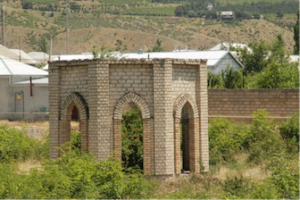
Above and below: The Shikhmezid Tomb
_______________________________
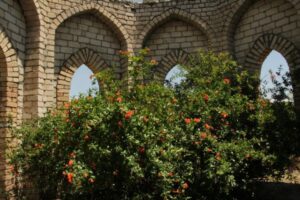
_______________________________
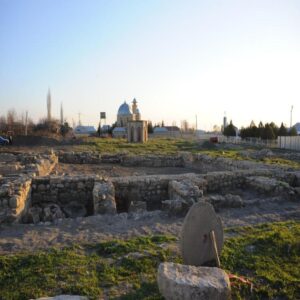
_______________________________
Shikhmezid Khanghah
The main part of the Shikhmezid khanghah, i.e., the mosque-madrasa building, was discovered during the archaeological research conducted in 2012-2013. The building consists of a main hall and cells, looking like Khalwatiya dargah. The walls here were built of well-hewn limestone and slaked lime was used as a fixing mortar. Huge walls give the building a special look. Numerous baked brick moldings and turquoise tiles indicate that the building had a brick dome. It is evident from the pottery-ware and other objects found there that the building was in continuous use since its construction. Unfortunately, other remains of the building extend to the land to the east and north, which is now used as a yard.
The exhibition, “Shikhmezid khanghah in Medieval Agsu City” is open in the historic Juma mosque on the territory of the “Medieval Agsu City” State Historical-Cultural Reserve. The exhibition is dedicated to the 10th anniversary of the excavations.
______________________________
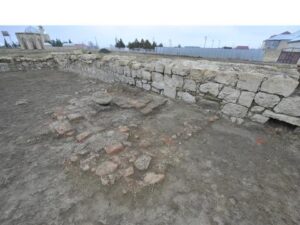
Above and below: Shikhmezid Khanghah
______________________________
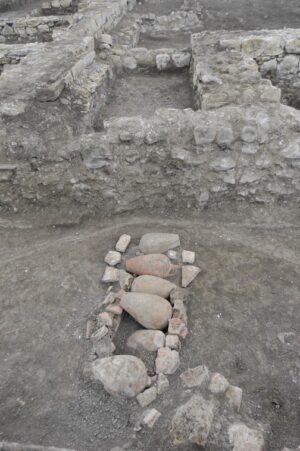
______________________________
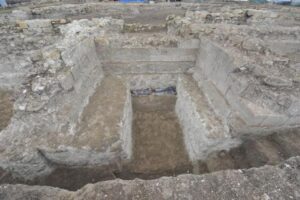
______________________________
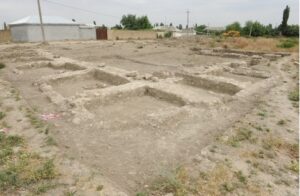
______________________________
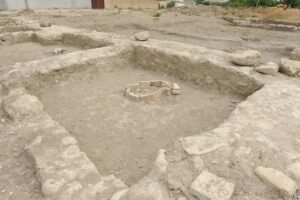 ______________________________
______________________________
Jar-shaped graves
One of the important results of the archaeological excavations are the graves covered with jars (pitchers), which were found in the cemetery built to the south and west of the mosque-madrasa. Such Muslim graves were not recorded in the archaeology of Azerbaijan so far. It is interesting that jars were used instead of birthstones for both men and women grave sites, as well as for both adults and children. After a grave well is dug, its edges are built with river stones or baked bricks. After placing the corpse in the chamber, well-hewn wood is laid on, and the jars are arranged on it in a zigzag form (the jar’s edge facing north and south respectively). The number of jars differs: 9, 8, 7, 4, etc. This number is related to whether the grave belongs to an adult or a child. All discovered skeletons were studied by an anthropologist and it was confirmed that they belong to the Caspian anthropological type of southern Europeans.
Monitoring revealed that the remains of the walls and bent parts of the khangah were etched, eroded, and moss was found in the stone part. Various types of weeds and shrubs were found in the khangah area, damaging the monument. The collapse and removal of stones are fixed in some parts of the walls, about two meters and in some about a meter, caused by anthropogenic impacts. The monument must be re-cleaned in order to restore the khangah as it was during archaeological excavations. The research should be continued on both the mosque and the tomb, and necessary restoration and conservation work should be carried out.
_______________________________
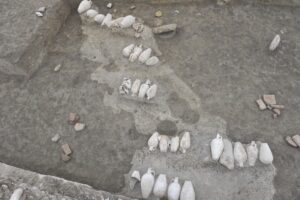
Above and below: Jar-shaped graves
_______________________________
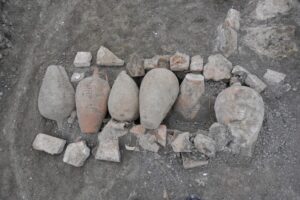
_______________________________
Advertisement

See the incredible archaeology, architecture, and art of northern Spain. A unique tour with special expert guides and lecturers through the collaboration of Popular Archaeology Magazine and Stone & Compass Tours. Not to be missed. Read More About It: https://popular-archaeology.com/article/northern-spains-triple-a-archaeology-architecture-and-art/.
_______________________________





